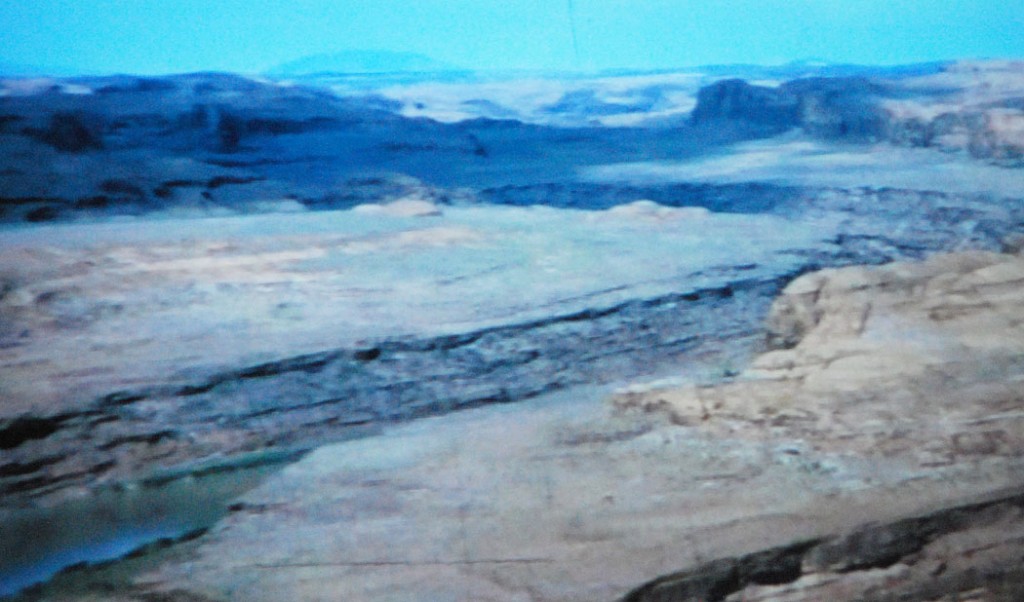 River activist Katie Lee reveals a film, locked away for half a century, that brings Glen Canyon back to life.
River activist Katie Lee reveals a film, locked away for half a century, that brings Glen Canyon back to life.
The float trip begins with laughter and exuberance. They bounce on their inflatable raft, wear outrageous hats and skinny dip in the muddy river.
By the end, the awesomeness of the desert canyon swallows up everything. The pace slows. The landscape dominates. A sense of wonder takes over. When the images stop and the words “The End” appear on the film, they say so much more than just the end of the movie.
“How can anything, any reality be this perfect?” asks Katie Lee.
At 90, Lee is the godmother of desert rat environmentalists, a former actress and folksinger who became a lifelong crusader to drain Lake Powell and restore Glen Canyon.
On Thursday, she appeared in Aspen, Colo., and unveiled a home video she shot of her last float trip through Glen Canyon, maybe the last trip anyone took through the expanse of red rock country. Projected onto the big screen at Aspen’s Wheeler Opera House, part of a fund-raiser for KDNK Community Radio, it was the first time the film had ever been shown publicly since 1962.
“It’s not very professional,” Lee apologized.
But it is magical.
It was October 1962, just three months before the floodgates of the Glen Canyon Dam would close and the canyon would drown beneath Lake Powell. The wild canyons would become a playground for party boats.
Lee loved this canyon since she first floated it, and returned to it some 16 times, often for weeks at a time. This last time, she led three friends by raft through the canyon to document it, on film and paper, before it would be inundated.
“It was a paradise,” Lee said. “It had 125 side canyons, every one of them different. It had a beauty that brought tears to your eyes every time you turned around a corner. No one had ever seen paradise like this. And we were able to get there before it was messed up.”
“Messed up” is a kind way to put it for Lee, who remains a rabble-rousing firebrand, prone to f-bombs, off-color jokes and referring to the hardware at the end of the canyon “that damned dam.”
Her film has a home movie quality, with hammed shots of rock scrabbling and skinny dipping, pancake eating and boat packing. It is most stirring, though, when the trip gets into full swing and the canyon reveals its mystery. The waters are not the crystal clear blue of a still lake but a muddy, churning current. It cuts through red rock canyons, with soaring spires and gaping side canyons and ruins of failed mines and ancient Indian dwellings.
“You could still see the fingerprints left in the mortar of their ruins,” Lee says.
It’s all under water now.
Marked by scratches and washed-out colors of old celluloid, the 22-minute film becomes more and more sublime until, like the canyon, it ends abruptly. Lee was so enraptured by the canyon, she took too much footage and ran out of film halfway through the trip. Her colleague Bruce Berger, the only other of the four-person group still alive, was writing about the canyon. He ran out of paper, too, and kept going, scribbling tiny letters on the cardboard of his notebook.
“It was a beautiful and fulfilling experience,” he said, “but it was also a tragic experience because we knew everything we saw and loved and admired and wanted to go back to was going to be destroyed.”
Lee has dedicated her life to fighting for Glen Canyon. Once an aspiring actress, she left Hollywood in the 1950s to play coffees shops and cabarets as part of the blossoming folk scene. She met Berger in Aspen, where she lived and was among the up-and-coming folksingers playing at places like the Limelight, then the proving grounds for singers like the Smothers Brothers.
After falling in love with the Colorado River on a river trip in the 1950s, Lee directed her music and activism toward fighting to protect Glen Canyon, first fighting to block the dam, then fighting to open it and let the river return. She now lives in Jerome, Ariz., the state where she was born.
“I was lucky,” Lee said, “and don’t think I don’t know that I’m one of the luckiest people on this planet today because I got to see it before anyone messed it up. I got to look at paradise.”
She and Berger both serve on the advisory board of the Glen Canyon Institute, which advocates for draining Lake Powell.
They remain hopeful that one day Lake Powell will be gone and Glen Canyon will return. Until then, it remains in their memories, and on 22 minutes and 12 seconds of film left almost unseen for almost half a century.
Ninety-three days after she shot it, Lee said, “the dam diversion tunnels were closed and you never saw that (canyon) again. No one ever saw it again. It was gone. And it’s still gone.”


